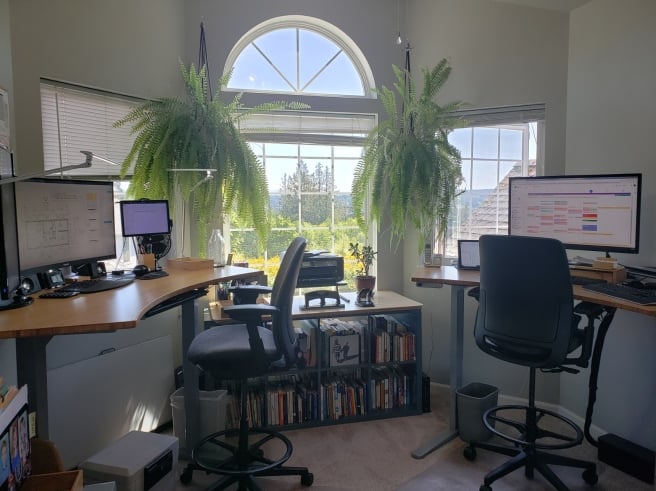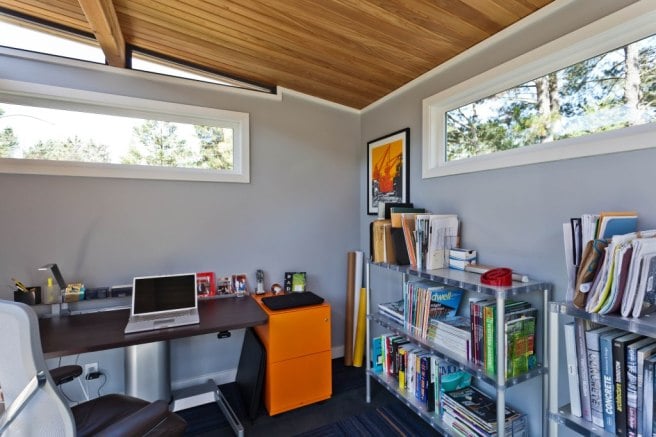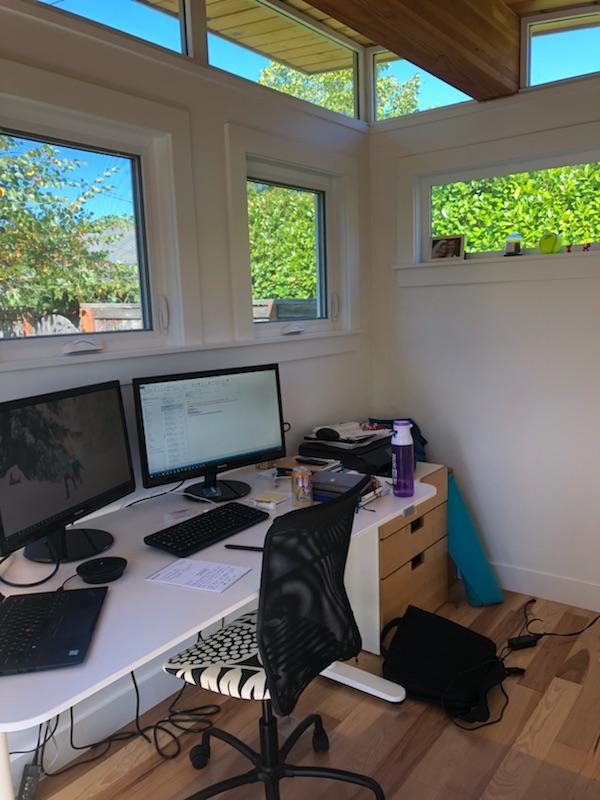#WFH – Operational Preparedness
By Tim Vack, Modern-Shed General Manager
Now that we’ve talked about how to be mentally prepared and how to prepare your physical surroundings for working from home, earlier in our series, let’s tackle how to prepare operationally for #WFH.
Setting up your computer and peripherals:
Some of you may have never set up a computer before because you have an IT person at work. My guess is that if that is the case, your IT person will guide you to get things set up at home. Many businesses use a virtual environment or remote desktop that, once set up, your IT department can access.
As stated in an earlier blog post, your desk size and location are of utmost importance. Two of our Modern-Shed employees have monitor arms which allow their external monitors to be positioned any which way that suites them. This is very helpful for numerous reasons, not the least of which is switching it up occasionally to make things more interesting or moving your personal position in relation to sunlight as the seasons change.

My monitors sit on my desk but swivel and go up and down. They are also curved slightly which helps the transition from one to the other and keeps the screens a better relative distance to my eyes. Typical computer systems include a computer or laptop, keyboard, mouse, monitor(s) and printer. If you use a laptop with a built-in keyboard and trackpad, I highly suggest getting an external ergonomic keyboard and mouse … believe me, it will make your daily computer tasks much easier and help reduce chance of carpel tunnel.
The first purchase after your desk and chair is a high-quality surge suppressing outlet station with enough outlets for your computer, monitor(s), and any other expensive equipment. These units help control power to these items and reduce the chance of damage in the event of a power surge through your home.
You will now find yourself in cord mania. You will not believe how many cords it takes to run an office. I think there may even be a career or at least courses on cord management. If you only use one monitor or one laptop, that is easy. However, if you use multiple monitors including your laptop screen, you’ll need to arrange them in a way it makes sense for your work. Computers can “detect” monitors and allow you to visually arrange them (on your computer screen) so each knows where it is in relation to the others. One of our draftsmen has his monitors stacked one above the other with the top one tilted down so when he wants to see it, he looks or glances up, and his main screen is at eye level.

One of our design pros has a “portrait” (most are typically landscape) monitor which he likes to use for his email because it allows him to see more of them at once. I have 2 large landscape monitors touching each other side by side because I use a lot of large spreadsheets and keep an eye on our production calendars which are wide.
If you use a laptop, consider a docking station to reduce the number of attachments directly to your laptop and outlets. You may also have an external hard drive, a printer, lighting, speakers, etc. with cords. Even though you can get some of these items cordless, you will still be surprised at how many cords you will have: power cords, video cables, USB cables, etc.
I have 18 cords near my desk, including the ones for the modem and router. All it takes is to move your desk location one time to make you scratch your head and say, “What in the world are all these cords for?”
So, in order to not go too crazy around it, place all your items first. You will need to deal with the temporary cords dangling for the moment. Plug each cord into the peripheral first and see if the cord is long enough to reach its intended source, like the computer or the docking station and the power source. You may find if you cannot move the peripheral, because it is in the most desired location, you will need longer cords or an extension cord. If you use any extension cords be certain to use the correct gauge cord for the use. Once you have everything where you want it, try to route cords together to the power source. There are all kinds of cord management tools, from cord trays to zip ties. Mine attach to the bottom side of my desk and utilize plastic clasps that adhere. I also use zip ties to wrap cords as it is easier to handle or route a bundle of cords.
However, when using zip ties, use caution when cutting them off when the time comes. ALWAYS unplug cords from outlets when re-routing. I also have Velcro straps to wrap cords together if they are more temporary. If all cords are plugged into the peripherals, be sure the power strip(s) are OFF and then plug everything into the power before turning the strip ON. The above procedure reduces chance of shock and damage to electrical components.
What to wear:
I have worked in my bathrobe, underwear, and sweatpants over the years. At the beginning of my #WFH experience, my desk was in my bedroom and because of my work ethic, I turned on my computer as soon as I got out of bed, and then, of course, got engrossed in work and soon it was mid-morning and I was still in my robe.
Everyone now is teasing and chatting online about working in sweats, not taking showers, not putting on make-up, etc. I must admit, I wear sweats much of the day, and do not always shower every day. However, I have been doing this an exceptionally long time, live alone, have very few video calls and I have a very strong work ethic with the ability to stay focused. If you are just beginning this and / or if it is challenging for you to get focused on work, I recommend you start your day just as though you were going to work. That means, shower and put on appropriate clothing for the office. Especially if you do video conferencing. However, I do think that you can be more casual and comfortable if doing so helps you be more comfortable and productive.

I have never believed you had to be in a suit and tie to do your job. But then I used to be in the corporate wearables business, which promoted logoed shirts. Since the idea of working from home is new to most businesses, they probably do not have any kind of “protocol” for what you should wear or look like. But it might be a good idea to check with the boss.
Technology:
Luckily, we live in a hi-tech world now. This allows us to stay in touch easily from wherever we are. For some people, like contractors or construction workers, their trucks become their offices. With Wi-Fi, hot spots, cell phones, cloud computing, video calling, VOIP phone services, etc. working remotely has never been easier.
At Modern-Shed, we use an online phone system, so we do not need to have a typical in-office phone system. And it is very inexpensive. We have 1 phone line and all calls are routed via each person’s extension to their cell phones. We use Microsoft OneDrive to store all our documents that we can each access with varying permissions. We can simultaneously collaborate on a document in real time. Other services such as Google Docs allows similar collaboration with their version of word processing and spreadsheet programs. Conference calling and video calling and desktop sharing programs such as Skype, Zoom, Google Hangouts, Microsoft Teams, GoToMeeting, etc. allow us to not only talk to each other, but to talk with each other as groups from several locations. All you need is a webcam. You can use your computers, your phone or purchase a separate cam.

When video calling, be aware of the lighting in the room/on your face, your head position (so they are not looking up your nose), and what is behind you. If you are conferencing a lot, a good microphone is especially important. Also, there are programs like Microsoft Teams and Slack that allow you a ton of options for chatting with each other instead of using emails and trying to track emails. However, be sure your chat program can allow saving of the chat dialog. When communicating with customers or team members it is nice to have all those communications saved and in one place so you can go back later without having to scour through texts, emails and chats.
Good luck on this chapter of your career, working from home! Read my previous posts about being mentally prepared and physically prepared for Working From Home. In our next post, we’ll talk more about discipline and managing distractions like pets, spouses and children, with insight from Modern-Shed design pro Jeff Bergerson, who works from home with his wife Leigh and their three children.
If you are interested in speaking to someone at Modern-Shed about a home office option for you, please visit www.modern-shed.com and download our catalog or go to contact and “find a design professional” and enter your zip code.
Related
Katherine’s One-Room Schoolhouse In "wfh , working from home , work from home"
Get In The Picture Contest with Modern Shed In "wfh , working from home , work from home"
Should Have Bought A Modern Shed In "wfh , working from home , work from home"







